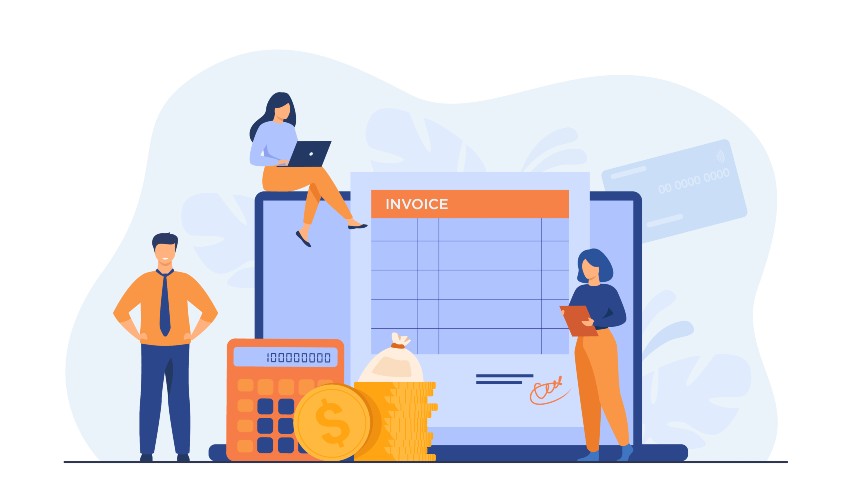Decoding the Accounts Payable Workflow for Effective Automation

Key takeaways
- Streamlined accounts payable workflow enhances transparency, accuracy, and efficiency in vendor payment processes.
- Full-cycle AP process includes 3-way matching, invoice approval, and payment processing for financial accuracy.
- Automating AP eliminates paper clutter, reduces errors, and improves vendor management and cash flow.
- E-invoicing and automated 3-way matching standardise and speed up accounts payable operations.
- Choosing cost-effective, user-friendly AP automation software like Cflow optimizes workflows and strategic focus.
The purchase of goods and services is the lifeline of any business. The goods or services required for running the business processes need to be purchased from reliable sources. Timely payment to various vendors is essential to build long-term relationships that are mutually beneficial.
The accounts payable (AP) process involves the management and execution of the company’s short-term payment obligations to vendors/suppliers. Having a streamlined accounts payable workflow improves the transparency and accuracy of buyer-supplier transactions. The accounts payable process is an important part of the procure-to-pay process. Read on to understand the accounts payable cycle and effective ways to streamline the accounts payable process flow.
Understanding the Accounts Payable Workflow
The accounts payable (AP) workflow includes all the steps between creating and paying for orders. The accounts payable process workflow covers any transaction that involves payment, to both external and internal payments. External processes include all kinds of payments to external vendors. Internal processes include internal accounting transactions like expense accounts charges.
What is a workflow in accounts payable?
All the essential steps are needed to complete a purchase when an order is placed, and the customer receives the desired product or service. The accounts payable process also includes the best practices related to these steps.
The full-cycle accounts payable can be mapped using the accounts payable process flow chart. Accounts payable procedures include invoice data capture, coding/creating invoices (with information on amount and cost center) approving invoices, matching invoice data with purchase orders, and posting for payments. The accounts payable process needs to be streamlined for managing the accuracy, consistency, and efficiency of every step in the process.
There are 3 main documents that are required for the AP processing cycle – purchase order (PO), receiving the report, and vendor invoice.
Purchase order- A purchase order is initiated when the purchasing department sends a PO to a vendor containing information on requested merchandise, quantity, and price. Once the vendor accepts the PO, it becomes a legally binding document.
Goods received a note – Once the goods are delivered by the supplier, the goods received note (GRN) is created. The GRN contains information about the shipment (quantity) and details on any quality and quantity discrepancies.
Vendor invoice – Upon successful delivery of goods/services, the vendor raises an invoice requesting payment for the goods/services delivered. The accounts payable (AP) accounting team then receives and processes the invoice to pay the vendor.
Why are the accounts payable process important for the smooth functioning of a business? The AP is a critical back-office function that has a direct impact on business productivity and efficiency. Timely and accurate execution of the accounts payable function ensures-
- Strong vendor relationships that are beneficial for the business
- Uninterrupted delivery of goods and services for smooth business operations
- No overdue or wrong payments, which saves the business from penalties or extra costs
- Systematic payment of invoices and payments to avoid missing or duplicate payments
- Reduced fraud or duplication risks
- Better management of the company’s cash flow
Decoding the Full Cycle AP Process
The accounts payable process flow is sometimes referred to as the “full cycle”. A full cycle accounts payable flow covers the entire payment process. This process flow is an integral part of the company’s financial statements.
Various steps in the full cycle accounts payable process vary with each company. However, there are certain common steps included in the accounts payable process, which are listed below –
- 3-Way matching – Upon receipt of the vendor invoice, the AP team performs the 3-way matching process to compare the information on the PO with that present on the GRN and vendor invoice. This is an important step that ensures consistency of information across various steps of the procure-to-pay process.
- Invoice approval – when the 3-way matching process is successful, it means that the vendor has billed the company only for the goods ordered and received. The invoice that passes the 3-way matching is then approved for payment processing. The approval is given through a voucher, stamp, or signature.
- The discrepancy in invoice – for orders where the quantity received does not match the quantity ordered or the quality of the product received is not as expected, the accounts receivable will attempt to track down the issue by backtracking to the vendor or the receiving department.
- Processing of payment – in large organisations, the treasury department processes the invoice payment. In small companies, the accounts payable department issues payments. Once the accounts payable department vouches for the invoice, the vouched documentation along with a cheque, is sent to the company’s check signer.
- Signing the cheque – the cheque signer then signs the cheque after verifying the supporting documents. The AP department then sends the cheque to the vendor and marks it as paid in the accounting system.
The full cycle accounts payable process takes care of the end-to-end processing of invoices and payments. The processes in the accounts payable function may be categorised as upstream and downstream processes. Upstream processes are efforts that occur in the procurement phase. Locating vendors that supply appropriate products or services is part of the upstream process.
An efficient upstream process ensures that strong vendor relationships are maintained and mutually beneficial contracts are created. Downstream processes are all the efforts that occur after the purchase of goods or services. In this phase, the AP team confirms the receipt of goods/services and tracks the invoices to ensure that proper authorisations are awarded for legitimate payments.
Challenges faced by the accounts payable department
Although the accounts payable procedures seem straightforward, there are some inherent challenges that prevent the team from optimising their operations. Accounts payable managers often face the challenge of having to do more with fewer resources to transform their team/departments from cost centres to profit centres.
The common challenges faced by the accounts payable team are:
- Excessive paperwork – the accounts payable function is among the most paper-intensive departments. More than half of the invoices received are in the form of paper documents. Missing or damaged invoices is another challenge of paperwork-driven processes.
- Time delays – the AP processing involves several review and approval steps. This causes delays in processing the invoice and paying the vendor.
- Matching errors – the 3-way matching process in AP processing identifies any discrepancies between invoices, POs, and GRN data. Identifying the source of the error and fixing it is a time-consuming task.
- Lack of visibility – paperwork and manual steps in the AP processing create blind spots that prevent the team from tracking the company’s cash flow efficiently. Lack of visibility into the status of the invoice increases the risk of late payments and makes it difficult to analyse the financial health of the company.
- Exception management – handling exceptions such as incomplete or mismatched information on invoices is a challenge for the AP team. Exception management requires a lot of time and effort.
- Unnecessary purchases – the absence of proper checkpoints and adequate controls over the AP processing steps results in unnecessary or unauthorised purchases.
All the above challenges faced by the AP processing team are mainly due to outdated manual processes. These challenges can be overcome by automating the AP process with the help of workflow automation tools like Cflow.
Ways to Streamline the Accounts Payable Process
Most of the challenges faced by following manual accounts payable processes can be eliminated by streamlining the process following the steps below:
Centralising all critical AP documents and automating processes on a single platform – centralising all the processes in the accounts payable workflow enables end-to-end automation. Automation brings the ability to capture, integrate, measure, process, store, and access critical AP information.
Minimise paper-based transactions – guidelines for vendor management must be set to submit digital invoices and leverage invoice capture software for automatic capture of information required by ERP systems.
Setting up payment reminders – delayed or missed payments can be avoided by setting up automated payment reminders.
Generate monthly reports – finance managers need to stay informed on the cash flow and always prepare for audits and information. Preparing monthly reconciliation, voucher activity, and payment history reports helps them stay updated and prepared.
Automating the Accounts Payable Workflow
Enhancing the accounts payable process through digital technology began as early as 1978 with Visical, the first spreadsheet software that was used for accounts management. From then to the current scenario where most of the accounts payable procedures are automated, Ap processing has come a long way. Modern accounts payable workflows are capable of invoice data capture, coding invoices with the right account and cost centre, matching invoices and POs, and approving invoices.
New technologies like workflow automation now provide businesses opportunities to derive more value out of their accounts payable processing. Automating accounts payable procedures like invoice data capture, 3-way matching, invoice approvals, etc. helps save time and costs significantly. With advancements in technology, accounts payable processing has improved by leaps and bounds.
End-to-end workflow automation
Build fully-customizable, no code process workflows in a jiffy.
Some of the latest advances in AP automation include:
- Accounts payable automation covers automatic invoice data capture and de-siloing data through ERP integration.
- Intelligent invoice automation technologies like AI-based classification and data extraction
- PO automation for keeping the business well-stocked and devoid of shortages due to human error.
Automating the accounts payable workflow centralises all the operations and access to documents. There are several benefits of automating the accounts payable process.
- Eliminates paper clutter, which in turn reduces processing rates and error rates
- Enables better vendor management and prevents fraudulent practices
- Links POs and invoices with electronic payments, providing a complete view of the accounts payable cycle
- Enables seamless 3-way matching
- Integrates the accounts payable process with other core business systems like ERP and CRM
- Eliminates the need for multiple checkpoints in the accounting cycle, which helps avoid unnecessary purchases and overspending
- Issues automatic alerts and notifications that are triggered when discrepancies are detected, and for payment deadlines
- Generates periodic reports and analytics that help managers understand the spending patterns in the organisation and prepare for audits and taxation
Accounts payable workflow automation has increased substantially over the past decade. Here are some of the most popular ways of automating the accounts payable workflow.
Switching to e-invoicing
An invoice is the first step in the accounts payable process, in which vendor invoices are received for payment. This is a critical point in the accounts payable process, which sets the tone for the rest of the process. It is a complex process that lacks standardisation for invoice capture. Since invoices come in different formats, consolidating, sorting, and scanning them is challenging. Shifting to e-invoicing sets a standard way to work with vendors and clients. It also eliminates the paper clutter in the office.
Seamless payment approvals
Invoice approvals often create significant snags and errors in the accounts payable process. However, approvals are key for verifying expenses and budget management. Automated AP workflow seamlessly routes each invoice to the appropriate person for approval. Automated alerts are also sent to the approver for approaching approval deadlines. Automation ensures that no time is lost and no paperwork is lost.
Do away with manual data entry
Data entry is a critical part of the accounts payable process. Data entry enables accounts personnel to spot trends and ways to increase profits. Automation can capture data by loading invoice data to the OCR system. Automating data capture and storing it in a centrally accessible medium enables easy, error-free data capture.
Automate the matching process
3-way matching is a critical part of the accounts payable process. Inconsistencies in invoice data and discrepancies between invoice data and PO data or goods received note data can be effectively identified during the 3-way matching process. Manual 3-way matching can be tedious and prone to error. Automating the 3-way matching process improves the accuracy of matching and speeds up the process.
Automating complex invoice coding
Coding and classification of invoices is the next most complex process to data entry. All payables go through a classification step called General Ledger (GL) coding. GL coding is an exhaustive process that helps identify a broad range of values for each invoice.
Some of the details included in the GL coding are the amount, vendor name, invoice category, product line, freight details, country code, business unit, department, and warehouse. Larger business units receive more invoices, and more voluminous will be the GL coding. Therefore, automating the complex GL coding process relieves the accounting team from tedious and time-consuming work.
Transform ACH spending to smart cards –
Moving their AP spend to a card is a transition that many AP managers are not comfortable with, as it does not allow auto-categorisation. However, transactions done via smart cards can be effectively auto-categorised based on the virtual card built for the vendor. For organisations paying their vendors via ACH, wire, or cheque, expense management and tracking can be cumbersome. Using smart or virtual cards allows them to float payments so that money does not leave their account until the payment is done.
Modern AP processes are being automated by AI-based and Machine learning software. A variety of software, like optical character recognition and intelligent data capture, is being used to capture key bits of data like the PO number, amount, date, etc. Workflow automation software also uses pre-set templates to convert all documents associated with AP management into digital versions.
Machine learning allows the AP system to learn from the main elements of the process and provide meaningful suggestions for the efficient handling of these elements. Such automation of the accounts payable procedures allows the AP team to devote more time to analytical and administrative functions that benefit the company.
Choosing the Right AP Automation Software
There are several ways to improve your accounts payable software, and automation is the most effective among them. Successful automation of the accounts payable procedures requires the AP manager to choose the right automation software. The right accounts payable software can create seamless workflow automation that takes care of low-value, repetitive tasks and allows the AP team to spend time on strategic tasks. How to choose the right accounts payable process workflow automation software?
Consider the following points while making the choice –
Does it address the pain points in the accounts payable process?
Existing manual AP processes present certain challenges to the accounting team. The account manager must choose software that addresses most of the pain points presented by current systems.
Is the price of the software reasonable? Is it a cost-effective solution?
Every investment made by a business is expected to provide quick and high returns. Accounts payable automation software is no exception to this. While choosing the software, do thorough research and analysis of the options available in the market. Going only by low pricing or rich feature set alone is not the right approach should take. For the price that you are charged, what are all the features provided by the software? Does it add value by improving the accounts payable process?
How complex or simple is the implementation of the software?
Automation software that is complex to install or implement is not value for money. Also, consider the team size while evaluating automation software. A smaller team can afford steep learning curves for mastering the use of sophisticated software, while a large team would require simple automation software.
Does it provide any additional features?
Checking if the automation software provides additional features that ensure smooth and effective implementation pays off. The AP manager must compare all the features of the software available in the market before deciding.
Choosing the right workflow automation software makes all the difference in the success of implementation. Cflow is a cloud BPM software that can successfully automate key business workflows like finance and accounting, marketing, HR, and procurement. The no-code workflow automation software can transform and streamline business processes within minutes.
Conclusion
There are several advantages of automating the accounts payable process workflow. From saving time and cost to streamlining operations to improving accuracy, the list of advantages is long. The full-cycle accounts payable workflow can be automated by Cflow. This feature-rich software comes at an unbelievably reasonable cost that is a complete value for your investment. With more than 20,000 users across the globe, Cflow is a trusted and preferred workflow automation software for small, medium, and enterprise businesses. Explore more by signing up for a free trial today.
What would you like to do next?
Automate your workflows with our Cflow experts.

